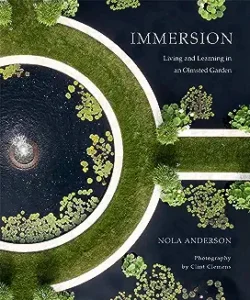Immersion: Living and Learning in an Olmsted Garden by Nola Anderson 2021
When Nola and John Anderson bought The Chimneys, a decaying property overlooking the Atlantic in Manchester-by-the-Sea, Massachusetts, they took on a massive reclamation project. The home had been built by Gardiner and Emma Lane in 1902 after they bought the land from Richard Henry Dana of ‘Two Years Before the Mast’ fame. The Lanes had torn down the summer house and built an imposing mansion, and more importantly, had contracted with the landscape designer, Frederick Law Olmsted,Jr to develop the gardens.
Olmsted’s firm in the hands of the famous Senior’s sons, drew detailed plans in 1902 for water, terrace, tea house, and vegetable gardens which were realized over the subsequent few years by a local construction firm and an army of gardeners. However, when the Lane’s only daughter died in 1992, both the house and the gardens had been neglected for 40 years and were in terrible condition.
Enter the Andersons who it appears had nearly infinite financial resources but alas, no garden experience. That challenge was taken up in earnest by Nola, a retired advertising executive, who spent the next 30 years learning about plants, soil, climate, and design and then utilizing that knowledge to reclaim these historic gardens. Her tutor along the way was Patrick Chasse, a landscape designer trained at Harvard School of Design with an office in Cambridge and a home in Northeast Harbor, Maine. Under Chasse’s tutelege, the gardens were restored largely along the lines that the Olmsteds had initially desgined, and in the process, Ms. Anderson became a plant and garden obsessive and expert.
The book is a love letter to those gardens brilliantly photographed by Clint Clemens. It succeeds in finding that balance that is often elusive for garden books between being a long list of plants and deteriorating into a ‘then I did this, and then I did that.” Anderson proves to be a pleasant and down-to-earth hostess as she takes us on a stroll through these extensive and quite beautiful gardens. I quickly gave up writing a list of plants I’d like to grow in Vermont as the list neared triple figures, but I thoroughly enjoyed the learning and loved the photos.
Sadly, the Andersons, aging as we all hope to do, sold the property in 2020 in order to move to that well known ‘condo on one level in a doorman building’, but Nola assured the reader that the new owners were plants people. Having now gardened in Vermont for the last 34 years, I can understand both Nola’s willingness and sadness in moving on. I, too, through a combination of aging back and muscles and something I’ll call ‘garden exhaustion’ have moved from the ‘develop a new garden’ phase to one of steady maintenance and enjoyment of what’s already there,
This is a fine book to curl up with on a cold winter’s night and revel in the potential for gardening beauty. One would need to have a huge bank account to accomplish what the Anderson’s did but it’s nice to dream. One caveat: the book weighs a ton, so if you do curl up with it, don’t fall asleep with it on your tummy, or you will end up with a bookmark!



